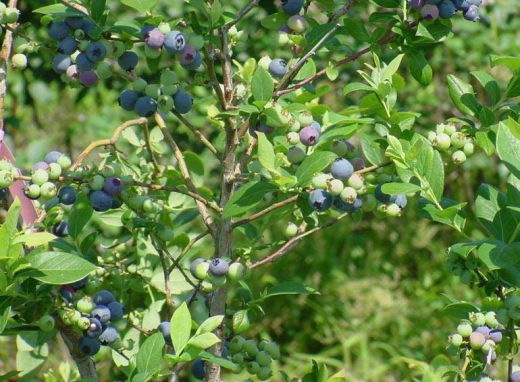At a Glance
A great feature of Palmetto is its good plant vigor, which would make this a very suitable home garden variety for those desiring highly flavorful berries. The plants have an open, spreading bush habit and narrow crowns. Since they bloom in early March in south Georgia, they will benefit from frost protection.
Fruit
Fruit are medium-sized with medium dark blue color. Palmetto has acceptable berry scar and berry firmness, although the scar can become wet and berries will soften if they hang too long on the plant after ripening.
Yield
Yields typically substantially exceed the Georgiagem variety. In its original south Georgia trials, Palmetto ripened more than 75% of its fruit during the first two weeks of May on average over a five-year period.
Cultivation
Propagation is easily accomplished from softwood cuttings. Chill hour requirements are similar to that of other early season Southern highbush varieties (such as Star and Neal) in the range of 350 to 450 hours. Plants are self-fertile to a degree but, to provide optimum pollination, should be planted with other Southern highbush blueberry cultivars with a similar time of bloom such as Suziblue. Commercial production of Palmetto may be limited to production scenarios where fruit flavor is desired and harvests are made frequently.
Development
Developed by D. Scott NeSmith of the University of Georgia, Palmetto is a hybrid containing mostly V. corymbosum and a small amount of V. darrowi. It is a joint 2003 release by the University of Georgia College of Agricultural and Environmental Sciences, the University of Georgia Agricultural Experiment Station and the U.S. Department of Agriculture/Agricultural Research Service. This protected blueberry variety can be sold only by individuals licensed by the University of Georgia Research Foundation (UGARF) and Georgia Seed Development (GSD). USPP 16,756.
Breeder

D. Scott NeSmith
Dr. D. Scott NeSmith’s blueberry research program at the University of Georgia emphasizes new variety development as well as cultural management of blueberries for the southeastern United States.
Since taking over the UGA blueberry breeding program in 1998, Dr. NeSmith has released and patented 10 new commercial blueberry varieties and two ornamental blueberry varieties. His breeding program is now considered one of the most active low- to-mid chill blueberry programs in the world. He joined UGA in 1990.
Dr. NeSmith has expanded UGA’s program globally through collaborative projects throughout the U.S. and many other countries including South Africa, Argentina, Chile, Uruguay, Japan, Europe, Morocco, Australia, New Zealand, South Korea, Peru, and Mexico. Much of his cultural management research has been with growth regulators in blueberries. He also conducts experiments on plant establishment, pollination, and post-harvest quality.
Dr. NeSmith is a member of the American Society for Horticultural Sciences (ASHS) and the International Society for Horticultural Sciences. He is a past President of the Southern Region ASHS and has served as an Associate Editor for the ASHS journal, HortScience.
Dr. NeSmith has received the D.W. Brooks Excellence in Research Award from UGA and in 2011 was selected as a Fellow of the American Society for Horticultural Sciences. He has published more than 250 research papers, including more than 97 in refereed journals, and has received two awards for outstanding publications.
He graduated from the University of Georgia with B.S. and M.S. degrees. He obtained his Ph.D. from Michigan State University.
Affiliations
- Department of Horticulture
- University of Georgia, Griffin Campus



